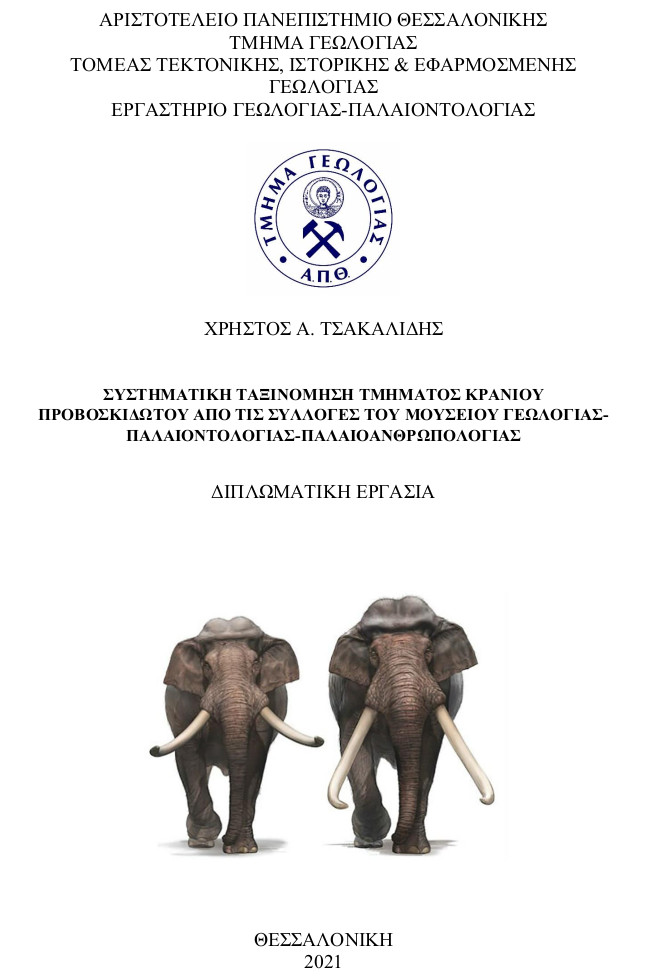
Συστηματική ταξινόμηση τμήματος κρανίου προβισκιδωτού από τις συλλογές του Μουσείου Γεωλογίας-Παλαιοντολογίας-Παλαιοανθρωπολογίας = Taxonomy of a partial proboscidean cranium in the collections of the Museum of Geology-Paleontology-Paleoanthropology.
Περίληψη
The taxonomic study of proboscidean fossil remains found in the surroundings of Tsotili village (Kozani) allow their attribution to the species Palaeoloxodon antiquus. The recovered material includes two upper molars and a nearly complete mandible which carries 3 more molars, 2 m2s that are located on the mandible and one m3 within the alveol. The taxonomy was based on both morphological criteria, such as the presence of the loxodont sinus, as well as on comparisons with other Pleistocene Eurasian proboscideans. The age of death is estimated at about 27 AEY while the paleoenvironment was fluvial as shown by stratigraphic data.
Πλήρες Κείμενο:
PDFΑναφορές
Μουντράκης Δ., 2010. Γεωλογία και Γεωτεκτονική εξέλιξη της Ελλάδας, Αθήνα, University Studio Press. Κουφός Γ., 2004. Παλαιοντολογία Σπονδυλωτών, Θεσσαλονίκη, Εκδόσεις Ζήτη.
Φουντούλης Ι., 2001. Η παρουσία θαλασσιών πλειοκαινικών ιζημάτων στην Μεσοελληνική αύλακα (όχθες Προμορίτσα, Γρεβενά). 9 ο Διεθνές Συνέδριο της Ελληνικής Γεωλογικής Εταιρείας με έμφαση στη Συμβολή των Γεωεπιστημών στην Ανάπτυξη, Αθήνα 2001, 603-612.
Φουντούλης Ι., 1999. Μορφοτεκτονικές παρατηρήσεις στη λεκάνη του ποταμού Προμορίτσα (Γρεβενά). 5 ο Πανελλήνιο Γεωγραφικό συνέδριο, Αθήνα 1999, 94-100.
Aouadi N., 2001. New data on the diversity of Elephants (Mammalia, Proboscidea) in the Early and early Middle Pleistocene of France. The World of Elephants - International Congress, Rome 2001, 82-84.
Barramundi A., Zhang H., Palombo M.-R., Ferretti M.P., 2020. The evolution of Palaeoloxodon skull structure: Disentangling phylogenetic, sexually imorphic, ontogenetic, and allometric morphological signals. Quaternary Science Reviews 229, 106090.
Diedrich G. C., 2014. Late Pleistocene Eemian hyena and steppe lion feeding strategies on their largest prey—Palaeoloxodon antiquus Falconer and Cautley 1845 at the straight-tusked elephant graveyard and Neanderthal site Neumark-Nord Lake 1, Central Germany. Archaeological and Anthropological Sciences 6, 271-291.
Dirks W., Bromage T., Agenbroad L., 2012. The duration and rate of molar plate formation in Palaeoloxodon cypriotes and Mammuthus columbi from dental histology. Quaternary International 255, 79-83.
Ferretti M., De Bruyne R., 2011. Anatomy and phylogenetic value of the mandibular and coronoid canals and their associated foramina in proboscideans. Zoological Journal of the Linnean Society 161, 391-413.
Kang J., Lin C., Chang C., 2021. Age and growth of Palaeoloxodon huaihoensis from Penghu Channel, Taiwan: significance of their age distribution based on fossils. PeerJ 9: e11236 http://doi.org/10.7717/peerj.11236
Kilias A., Vamvaka A., Falalakis G., Sfeikos A., Papadimitriou E., Gkarlaouni C., Karakostas B., 2015. The Mesohellenic Trough and the Paleogene Thrace Basin on the Rhodope Massif, their Structural Evolution and Geotectonic Significance in the Hellenides. Journal of Geology and Geophysics 4, 1-17.
Konidiaris G., Kostopoulos D., Koufos G., 2020. Mammuthus meridionalis (Nesti, 1825) from Apollonia-1 (Mygdonia Basin, Northern Greece) and its importance within the Early Pleistocene mammoth evolution in Europe. Geodiversitas 42 (6), art. 42(6), 67-91.
Kostopoulos D., Koulidou I., 2015. An early mammoth maxilla from north-western Greece. Quaternary International, 379, 155-163.
Maglio V., 1973. Origin and Evolution of the Elephantidae. Transactions of the American Philosophical Society, New Serries - Volume 63, part 3, Philadelphia.
Osborn H.F. 1931. Palaeoloxodon antiquus italicus sp. nov., Final Stage in the Elephas antiquus Phylum. American Museum Novitates 460, 1-24
Palombo M., Ferretti M., 2005. Elephant fossil record from Italy: knowledge, problems, and perspectives Quaternary International 126-128, 119-121.
Palombo M., etal, 2003. La Polledrara di Cecanibbio: one of the richest Elephas (Palaeoloxodon) antiquus sites of the late Middle Pleistocene in Italy. Deinsea 9, 323-326.
Roth V. L., Shoshani J., 1988. Dental identification and age determination in Elephas maximus. Journal of Zoology 214, 567-588.
Todd N. E., 2010. New Phylogenetic Analysis of the Family Elephantidae Based on Cranial-Dental Morphology. The Anatomical Record Volume 293, 74-90.
Todd N. E., 2010. Qualitative Comparison of the CranioDental Osteology of the Extant Elephants, Elephas maximus (Asian Elephant) and Loxodonta africana (African Elephant). The Anatomical Record Volume 293, 62-73.
Tsoukala E., Mol D., Pappa S., Vlachos E., Van Logchem W., Vaxevanopoulos M., Reumer J., 2011. Elephas antiquus in Greece: New finds and a reappraisal of older material (Mammalia, Proboscidea, Elephantidae. Quaternary International, Volume 245, 245:339-349.
Wei G., Hiroyuki T., Yoshinori K., Chan-zhu J., 2006. Pliocene and early Pleistocene Primitive Mammoths of Northern China: Their revised taxonomy, biostratigraphy and evolution, Osaka, Journal of Geosciences Osaka City University 49, 59–101.
Zhang H., Wang Y., Janis C., Goodall R., Purnell M., 2017. , An examination of feeding ecology in Pleistocene proboscideans from southern China (Sinomastodon, Stegodon, Elephas), by means of dental microwear texture analysis. Quaternary International 445, 61-70.
Εισερχόμενη Αναφορά
- Δεν υπάρχουν προς το παρόν εισερχόμενες αναφορές.
